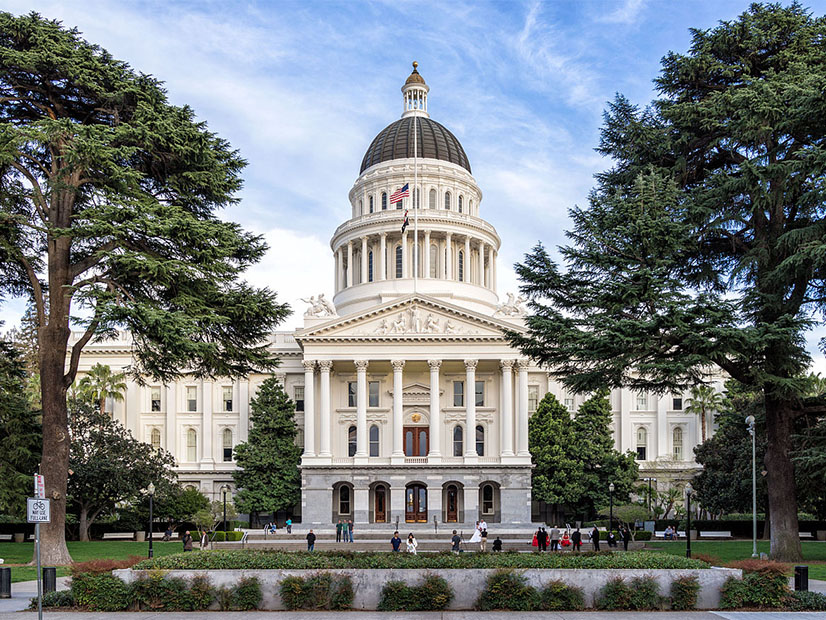
The office of California Gov. Gavin Newsom has proposed legislation that would establish a central procurement authority to ensure the state has sufficient electricity resources to avoid shortfalls as it struggles with extreme heat, tight supply and a changing resource mix across the West.
The proposal is contained in budget trailer bill language that follow’s Newsom’s fiscal year 2023/24 budget released in January. No lawmaker has yet signed on to carry the bill in the current legislative session.
The governor’s proposal would give the California Public Utilities Commission (CPUC) the option to name the state Department of Water Resources (DWR) or an investor-owned utility to procure energy for the state’s load-serving entities, including public utilities and community choice aggregators.
“For California to achieve its long-term greenhouse gas emission reduction goals, while maintaining a reliable electrical system and providing customers with greater choice in electricity retail providers, the state must establish a new central procurement function within the [DWR] that enables the development of a more diverse portfolio of renewable and zero-carbon energy resources,” it says.
The state has directed investor-owned utilities to procure for other LSEs in the past, but DWR has not performed that function. The governor’s legislative language would authorize it to do so if called upon by the CPUC.
The department’s State Water Project is a major producer of electricity through its hydroelectric projects and the state’s single largest consumer of electricity, which it uses to operate pumping plants that deliver water throughout the state.
Under the proposal, DWR could issue bonds and recover costs through ratepayer charges approved by the CPUC as long as the charges “[do] not unreasonably increase costs to customers … compared with the procurement of diverse clean energy resources by an electrical corporation.”
DWR would have to conduct a competitive procurement process and “prioritize investments that do not compete with the procurement of diverse clean energy resources already planned for development and disclosed by load-serving entities or local publicly owned electric utilities.”
LAO Report
In a March 10 report on the governor’s proposal, the state Legislative Analyst’s Office says that “according to the administration, the DWR procurement is intended to be for long lead‑time resources such as offshore wind, geothermal, and long duration storage. The proposed statutory changes, however, do not explicitly limit this procurement option to those types of resources.”
“DWR would utilize its new Strategic Reliability Reserve office and staff to manage the procurement,” the LAO report says.
The department administers the state’s Electricity Supply Strategic Reliability Reserve Program (ESSRRP), a $5.2 billion fund sought by Newsom in last year’s budget and enacted in June to pay for new generation and storage, to keep older natural gas plants online and to provide emergency backup generation through DWR. (See California to Pass Sweeping Energy Policy Changes.)
California has experienced blackouts and near misses the past three summers as it tries to shift its resource mix from fossil fuels to renewable power amid extreme heat, wildfires, drought and strained supply in neighboring states.
Another component of the governor’s legislative proposal is a requirement that load-serving entities pay for failing to obtain sufficient resources to meet demand by making payments to the strategic reserve fund. The move is intended to “discourage LSEs from over-relying” on the ESSRRP, the report says.
“The state would assess a payment if an LSE does not meet its reliability obligations in a month when the state had to access the ESSRRP,” it says. “Specifically, the payment would be based on a calculation that factors in the cost of the energy resource provided by the ESSRRP and the LSE’s deficiency in meeting its monthly resource adequacy or planning reserve requirements. The payments would be calculated by the CPUC and the California Energy Commission.”
The payments would be in addition to fines for resource inadequacy imposed by the CPUC.
Questions for Lawmakers
The LAO report proposes questions for lawmakers to consider when weighing the governor’s proposal, including the potential impact on ratepayers of adding DWR procurement costs to their already-high electricity bills.
It also questions the market effects of central procurement by DWR.
“The current market for energy resources is strained, with a large number of LSEs competing for a relatively small pool of projects that often will take years to develop,” it says. “How the entrance of DWR — a large, well‑resourced entity with the backing of the state — would influence the market for new energy resources is unclear.”
The report also questions whether the state needs new central procurement authority or whether current resource planning processes and the ability of IOUs to procure for other LSEs is enough.
Having DWR in charge of long-lead time resources poses risks, the report says.
“The administration has expressed concerns that LSEs might be hesitant to procure large, long‑lead time resources because of their high cost and risk as newer technologies,” it says. “The Governor’s proposal to have the state pursue procuring these resources instead essentially shifts this risk from the privately owned utilities (and their investors) to ratepayers and taxpayers. While this could help facilitate the development of these important resources, additional information is needed about the types of risks involved and their magnitude for the Legislature to determine if they are worth the potential benefits.”
Finally, the LAO asks whether the energy policy changes should be considered as part of the budget process.
“The Governor’s proposals represent significant policy changes for the state, and they do not have a particularly strong nexus with the budget,” the report says. “The Legislature will want to consider the most appropriate venue for discussing and deliberating these proposed changes. For example, the Legislature could consider these proposals through the policy process, rather than as part of the budget process.”
